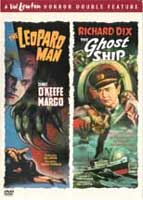
BUY IT AT
AMAZON: CLICK HERE!
STUDIO: Warner Bros.
MSRP: $59.92
RATED:
NR
RUNNING TIME: 66/69 min.
SPECIAL FEATURES:
• Commentary with Director William Friedkin on The Leopard Man
•
Theatrical trailer for The Leopard Man
Note: These two films aren’t available separately, so consider yourselves lucky to have to purchase the entire Val Lewton Horror Collection! Click on the art below.
Read Thor’s DVD Rack of I Walked With A Zombie/The Body Snatcher here.
Val Lewton once remarked about the power of the imagination onscreen: "If you make the screen dark enough, the mind’s eye will read anything into it you want!" So, serving as a counterpoint to Universal’s highly lauded Classic Horror flicks of the earlier part of cinema’s birth (you know them well, I’m 100% positive), Lewton’s rag-tag unit at RKO did just that; allow your own mind to wander around with the innumerous possibilities at what’s lurking on – and off – screen. The trick worked well enough for him to bankroll several films with his relatively cheap antics, ushered forth from some soon-to-be-well-known filmmakers. Many of which Warner Brothers have packaged in their Val Lewton Horror Collection (buy it here!), a real treat for any fan of discovering the genesis of psychological horror.

"You know, I may be blind, but I can still see that you’re full of shit."
The Flick(s)
Each disc contains two films, so for purposes of making this review easier to read, we’ll discuss both films in the same block. The first film is The Leopard Man, the third and final collaboration between Lewton and famed cinematic master Jacques Tourneur (the first being Cat People – Russ is tackling this DVD review, and the second – the masterpiece I Walked With A Zombie – see Thor’s review above). What makes Tourneur’s accomplishments so much different from that, of say, Mark Robson or Robert Wise, is that he understood the fundamentals of what Lewton preached. Sticky shadows, twisted emotional resonance, even the necessary evil lurking behind every dark corner imaginable helped mold Tourneur’s film. Not to say that Robson or Wise didn’t utilize their formidable talents as well, it’s just that I feel that Tourneur was a step ahead of them.
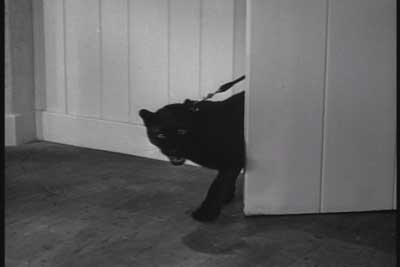
"Hello, bitches!"
Night has enveloped a small town in New Mexico, the type of hole-in-the-wall where people get their kicks from the cadre of entertainers who breeze in and out of town on a whim and a meager budget. It’s there where three women – one a young girl with a penchant for being afraid of the dark, the other a flamboyant dancer with so-called talent named Clo-Clo, and the last, Consuelo, a woman whose idea of love revolves around meeting her love in a local graveyard. All three of these women will perish throughout the film, victims of fate as much as they are of circumstance, bad timing, and the shrouding of the night. Oh, and a big hungry Leopard.
It’s also necessary to note that Clo-Clo has sort of upstaged one of these other performers who has been in town for some time, along with her Press Agent Jerry Manning (played with inquisitive gusto by Dennis O’Keefe, not that his name means anything to the crazy kids who read this site, unfortunately). So, being the forward thinker that he is, Manning arranges with a local Leopard handler to have his gigantic black Cat make a show stopping entrance alongside his own client. It works like gangbusters (a term that makes me as uncool as Herpes), enraging Clo-Clo to the point of scaring the Leopard away, carelessly disregarded and stalking out into the night.
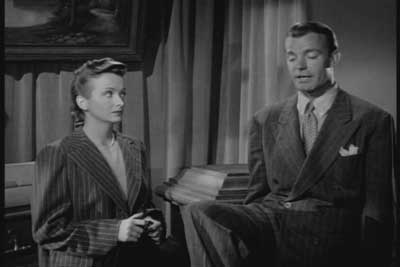
"Damn this Boner! I need to walk!"
As the Cat is loose, strange things start happening around town. First, the young Teresa Delgado is forced to get some cornmeal for her father’s dinner all the way across town. In a bravura sequence that emphasizes shadows and light over slam-bang-thanks-to-your-Mom imagery, Tourneur ratchets up the tension like few older horror films I’ve ever seen. Sounds, and the lack of any music, save for the wild sounds around Teresa, have a profound effect. Ultimately chilling (along with more than a few "aw, hell no! don’t do that!" moments), Teresa’s untimely death plunges the picture (and the town) into a heightened sense of security. Anyone could (and would) be next.
There are two more victims after that, and Jerry especially starts asking questions right after Consuelo is sent writhing in agony into a nice plot six feet under. It’s funny how her death works out in the end, considering she’s killed in a graveyard, although the film never makes it clear by whom (until the end, that is). Tourneur takes delight in relishing a series of shadowy premonitions, followed by the stunning simplicity of having the wind rustle and the trees hide what light cannot: that of evil, death, and destruction. The general theme of fate plays a primary role in shaping The Leopard Man as well. While these women really have nothing to do with one another, it doesn’t stop Tourneur from following one and then mid-shot turning and going right along with the other whilst they’re still fully functional.
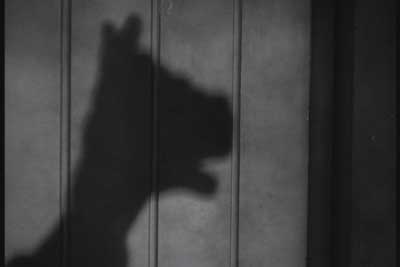
Cheap theatrics makes everything better!
Speaking of which, the idea of fate being the motivating factor behind the universe is of massive importance towards the narrative events of the story. Not only does a Fortuneteller have a fairly enlarged role for such a short B-picture (66 minutes to be exact), the ideas expressed behind her choice of cards – the dreaded Ace of Spades keeps popping up, much to her dismay – allows us to realize that Clo-Clo’s days are numbered. It’s in the next couple of moments where not only do we anticipate when and where she’s going to see the Reaper, but how. These series of chances, of doomed fates not only plays a role within Clo-Clo’s story, but within the developments of the other victims. They are resigned to their fates whether or not they like it as well. It’s so unpredictable, it really can’t be fully explained. Get out of jail free card for me!
The title is more than a misnomer, especially since, as Cat People demonstrated, I was expecting a sort of supernatural hybrid of a man who was using his Leopard as a means of living out his own horrific psychological need to kill his victims. Such isn’t the case, though, as The Leopard Man refers to the man who gives Manning his pussy without as much as blinking. Although, like the pimp he is, they do have an arrangement, and it involves a lot of money, if his primed possession (for most men) happens to fall into the wrong hands.

"Listen to me: don’t be such a pussy, pussy!"
As for the person responsible for killing two of the three females (the first killing is intentionally vague, and although I think the actually Leopard maimed and ate her for its scrumptious snack, it could be argued the other way around. But – you’d be wrong.), the psychological implications are interesting. Not only for such an early period in filmmaking history, but it presents a person of relative importance as having some serious issues. The film takes no stand against this person’s ultimate confession, or feelings towards killing, but it does present something of a modern example of a killer who could be just like you or I (coincidentally, almost all of Lewton’s horror films have this same idea running through them, even Ghost Ship).
Anyway, Tourneur, along with Lewton, makes good use of the idea behind what’s lurking in the shadows. Leopard Man is most notable for its shocking depiction of some most heinous (party on, Wayne) death scenes, most prominently with the aforementioned stream of blood oozing underneath the doorway of the Delgado household and the way a crime scene is portrayed overlooking a graveyard’s walls. And while the film falters as a whole, in terms of what occurs and how the actors use their own talents in front of the camera, The Leopard Man is still good enough to have a cluster of some truly frightening moments. Unless, that is, you’ve been distilled and desensitized from years and years of crappy-executed, yet entertaining schlock on television. In that case, The Leopard Man is most likely going to be rather stilted and boring to you. But, should you care enough to see how the evolution of the modern horror film began, The Leopard Man is likely right up your alley, provided that it’s dark enough and scary enough to warrant your own killin’ desires.
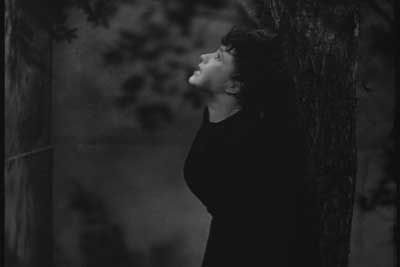
"Margaret! It’s me – GOD! So sorry, but –
you’re FUCKED! See you soon!…"
The Leopard Man: 8.2 out of 10
Next is The Ghost Ship, which while atmospheric to the max, contains a fairly ho-hum performance by Richard Dix as the Captain of the eerie vessel Altair. It does, however, open up against the relatively eerie and foreboding unbroken shot of the Ship coming in through the fog while the Opening Credits come in and out. Setting the right tone, the rest of the film follows the newly commissioned Third Class Officer Tom Merriam as he discovers things on the Altair that sometimes lead Men to depths of insanity and out-and-out evilness.
Director Mark Robson makes terrific use of a general sense of despair, as a terrific doom hangs over all who are in the Altair’s space. Odd moments, such as a freshly painted Ship’s Hook dangling to and fro without regard to life or limb, coupled with a ship’s mates roll call that ends on a sour note (hint: one man doesn’t make it … for eternity!), and a frightening accident regarding a man who confronted the Captain, make for a wonderful sense of cataclysmic doom. Spectacularly enough, these moments all happen before the crew even makes their first landfall. That’s what I call productivity for Mr. Death, wherever it may be.

"Don’t worry Mate – last person I did this to was
Andy Kaufman, and look how he turned out!"
As it stands, The Ghost Ship is almost three films. However, they all tie together, but it has three distinct areas of story. The first is the awful events that placate the arrival of the Altair into the port of somewhere or other in the Southern Seas (it’s a Spanish speaking country that I forget – sue me!). It’s there where Tom’s discoveries of what the Captain may or may not be capable of lead him to rethink his priorities. After all, he’d rather have Captain Stone stripped of all command than lead a group of Men into a hazy breech filled with darkness and bloodied consequences. He’s got morals, dammit.
The second is at the Port, which has Merriam confronting Stone at a public tribunal of sorts, as the Crew Mates come forth and actually flip-flop, telling the gathering overseers of Stone’s humility, courage, and resolve. Defeated, Merriam immediately gets off the ship, saddened with his prospects of being on a ship ever again with this blot against his record.
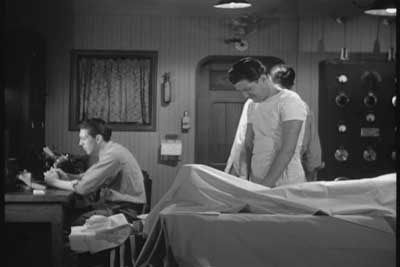
Even when Henry wasn’t looking, Jimmy kept
trying to slide Mr. Johnson in bad places.
The last is when Merriam saves one of the Crew Mates in a fight, only to get knocked out himself. When he wakes up, it’s more than fate that he happens to find himself not only with a hazy memory, but back on the Altair. It’s like Disneyland, in the way that you keep going back and spending all your time there with some of the most frightening patrons imaginable. It’s within these final moments that Merriam comes to the subtle realization that Stone might be out to kill him, considering that he finds himself back onto a ship that doesn’t want him, along with a Crew who’d just as much spit on him than speak to him (except for the guy who happens to be a Mute). Call it a sneaking suspicion.
The general sense of paranoia really gets its just desserts within the scenes leading up to the relatively you-saw-it-coming ending. It’s not how it ends, but how it gets to that point, considering that Captain Stone once forcefully informed Merriam that as Captain he has both the power and authority to not only watch over his Crew, but to take their lives as he sees fit. It’s a strategy not unlike any other corporate entity today. The events that bombard their way into the final moments also enforce this sense of dread through the erratic behavior of Captain Stone, the entirely off-kilter way he seems to be going about his business in a subtle not-so-subtle way.
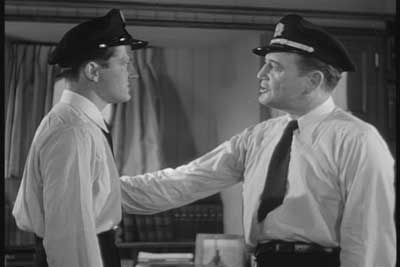
"Say, how’s about you and me go out for a little
dinner of snails, oysters, and some good old
fashioned mud wrestling?"
Richard Dix is Captain Stone, and while passable as an Actor, he gets to quasi-shine when delivering such good traits as telling one of his past lovers that he’s a part of the ship, and their time together has reached its post-marked date. It’s in that recollection that we see the seeds of a needy madman, one drawn to and entirely at the service of an unnecessarily frightening resolve with absolutely no regard for the consequences of the various lives that could (and would) be lost. And while I usually like to tell my own ex-girlfriends they’ve been dumped for some more hours at watching movies, I wish I could tell them it was because of my bastard ship and its needy arms. Maybe they’d understand then.
Robson and Lewton make fairly adequate use of the story, although similarities emerge towards a literary adaptation, that of The Sea Wolf, which hit a little too close to home for a couple of writers who happened to be fashioning Jack London’s novel into a play. They sued Lewton and Company and the result is that most people haven’t been able to view this film until recently. One of the most shocking scenes involves a knife fight that has a Man holding the blade of a sharp skewing stick with the grip of his FUCKING hand. That’s a MAN ladies and gentleman. Get him a medal, stat. That scene is particularly bloody, in the sense that bodily parts get slashes and tempers flair. The end result is something worthwhile, but I’d rather not spoil it. Credit the scene to Robson and Lewton, who appeared to have created something that works as entertainment, but isn’t the greatest film in Lewton’s cannon.
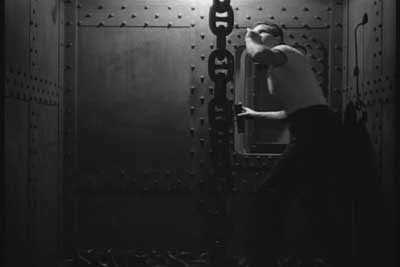
"It says: Trash Compactor 3263827!"
However, The Ghost Ship works because of the limitations in terms of extravaganza. The atmospheric qualities of the entire film will resonate with any anyone worth their salt simply because the imagery reinforces the moodiness and uncouth qualities of the events that are about to unfold before your own eyes. Dix’s shifty performance is quite a caricature, although done with no less expounding than that of the Killer in The Leopard Man. Both have their faults, and both have their tendencies to be homicidal maniacs. I think they’re both tremendous fun to discover, if only because at that point in time, Killer’s weren’t shown with such a blurry realization of life. It isn’t as cut-and-dry as most moviegoers in that era wanted them to be.
In the end, The Ghost Ship is entertaining enough to warrant a viewing, if only for the atmospheric effects rendered through the films lushly gorgeous photography. I particularly enjoyed it, so give it a shot, will ya?
The Ghost Ship: 8.2 out of 10
The Look
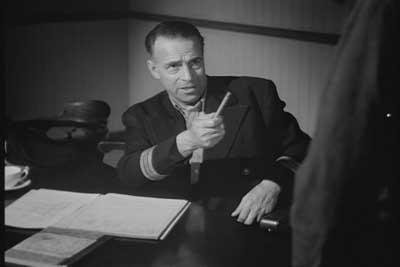
"Do you know where I could stick this?
Right up your Rio Grande, that’s where!"
Sadly, The Leopard Man has a black scratchy line that runs down the far right hand side of the frame and stays there, intermittently, throughout the entire film. It’s a shame, considering the amount of hard work Warner’s has been throwing into their older collection of films recently. Additionally, there is a rather disconcerting amount of scratches and dirty elements still left over from whatever remaining print Warner’s still has. It’s sad that the transfer is as inadequate as it is, but as a whole, it’s still good to have a sub-par version of The Leopard Man out on DVD than none at all.
The Ghost Ship fairs better, has no line running down the frame, and is along the lines of many of Warner’s other transfers on their much heralded older films. The imagery is clear enough to make your eyes happy, and not distracting enough as The Leopard Man so you can enjoy the film more visually.
Leopard Man: 6.5 out of 10
The Ghost Ship: 8.0 out of 10
The Noise
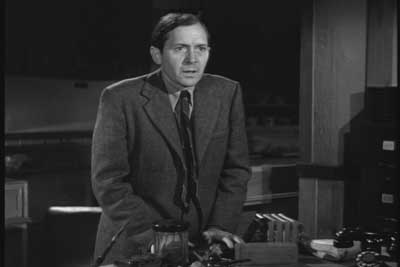
"Sometimes I wish I was Jeffrey Combs too…"
There’s bile-spewing mono on both films. I had to fiddle around with my Surround Sound system, which by all accounts, isn’t as advanced as some people. Being as old as these films are, the audio transfers are fairly equal on both films, clear enough to understand, but not really crisp enough to blaze through your system and permeate your room. In order to achieve that, it’s going to take some work on your ears and the abilities of your system.
Both: 7.0 out of 10
The Goodies
The Leopard Man gets a relatively expository audio commentary from famed filmmaker William Friedkin (To Live and Die in L.A., Exorcist, French Connection), which while having some good points to say, is straightforward and sometimes rather off-putting. It’s a shame too, considering Friedkin’s personal accomplishments (we’ll leave The Hunting off this one for now), and enthusiasm for the subject at hand. I particularly enjoyed his thoughts on the enemy of the horror film (coherency, which he jokes is just like his commentary) and the breakdown of simplistic elements in a Tourneur/Lewton film, although others might find this one a little too by-the-book for them and quickly shuttle off. It’s certainly not the best track you’ll ever be privy too, but it works for what it is.
Finally, there’s the theatrical trailer (runtime – 1:03) for The Leopard Man, which is kitschy enough but has a horrific video quality that recalls all of those days where I scoured the Earth searching for low-quality VHS’s of films in my local video store. While those days were fun, the image quality of the trailer isn’t.
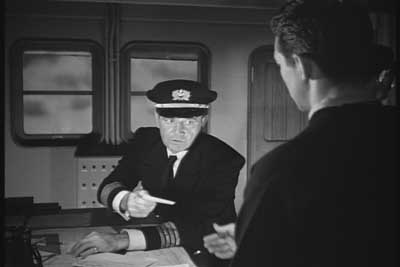
"And when you go out, remember – it’s all
18 Volumes of Where the Boys Aren’t … okay?"
The Leopard Man: 5.5 out of 10
Nothing on The Ghost Ship, so: 0 out of 10
The Artwork
 Most excellent, if only because the Studio’s art department has chosen to uphold some of the original one-sheets as the means of your own introduction to the film. My first impression of both was that of excitement, mostly because The Leopard Man has this very ethereal quality to it, one of terror by the extremely large sharp-clawed hand of the titular beast. The Ghost Ship is the better of the two, if only for empathizing the mysterious qualities of the film (knife fighting, sleeping, women being raped – wait, what? – and a steamship going into the night) all encased around the watchful eye of the darkly suspicious Captain Stone. They both draw you in, or at least they did to me, so consider them spectacular enough to gauge your interest. This is where a bad joke would go, but I just can’t think of one at the moment. Seek out these films!
Most excellent, if only because the Studio’s art department has chosen to uphold some of the original one-sheets as the means of your own introduction to the film. My first impression of both was that of excitement, mostly because The Leopard Man has this very ethereal quality to it, one of terror by the extremely large sharp-clawed hand of the titular beast. The Ghost Ship is the better of the two, if only for empathizing the mysterious qualities of the film (knife fighting, sleeping, women being raped – wait, what? – and a steamship going into the night) all encased around the watchful eye of the darkly suspicious Captain Stone. They both draw you in, or at least they did to me, so consider them spectacular enough to gauge your interest. This is where a bad joke would go, but I just can’t think of one at the moment. Seek out these films!
8.5 out of 10

The Leopard Man – 7.1 out of 10
The Ghost Ship – 6.3 out of 10
